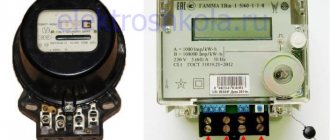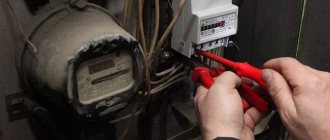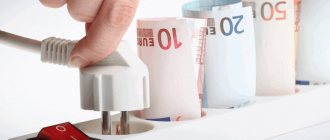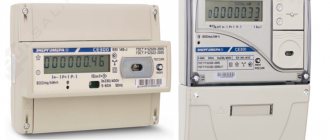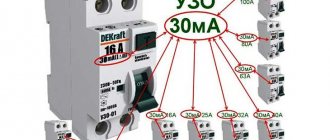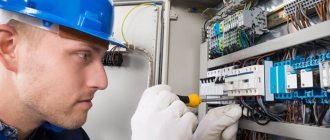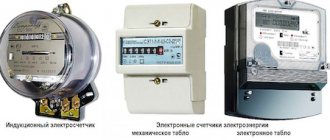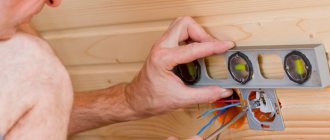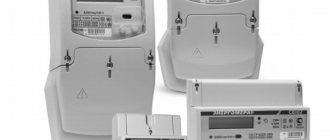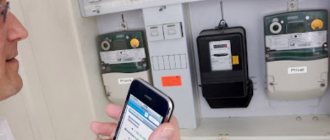Author of the article
Alexander Georgievich Kondratiev
An electrical engineer by training, he worked as an electronics engineer, chief engineer at a food company, and general director of a construction organization.
Before you begin installing an electric meter in a private home, you need to carefully study the rules. They differ significantly from the conditions for installing an electricity meter in an apartment. Typically, such metering devices are installed outdoors. This is necessary so that the energy sales inspector can easily check the status of the meter and monitor the readings.
Starting from July 1, 2022, new rules for installing metering devices will apply. Resolution of the Government of the Russian Federation dated April 18, 2020 N 554 “On introducing amendments to certain acts of the Government of the Russian Federation on improving the organization of electrical energy metering” was approved. Now electric networks install meters at their own expense, free of charge for the consumer.
According to the new law, all property will be equipped not with ordinary meters, but with “smart” ones - intelligent means of electricity metering (ISEM). For now, these are only recommendations, and from January 1, 2022, only smart devices will be allowed to be installed.
Electric meter on a pole: features of placement and connection
In recent years, the option of installing electric meters on a pole on the street has been very often used.
This is especially convenient for energy supply company employees when taking readings. In a private house, if the meter is located inside, readings can only be taken if its residents are present. When placing the device outdoors, the situation is different. Let's consider some features of the location of the electricity meter on the pole:
- Anyone who has skills in working with electricity has the opportunity to install electricity meters on a street pole. However, the right to connect electricity to the device is limited to representatives of the electricity supplier only.
- If the electricity meter is installed outside the premises, namely on a street pole, by representatives of electrical networks, then there should be no complaints against the consumer. Even before the start of installation work, documents are prepared that indicate the requirements for the installation of a specific metering device and the balance sheet boundary.
- Installation of an electricity meter on a pole is carried out only with the consent of the owner of the meter. In private houses, the balance sheet boundary is not indoors, but outdoors. In this case, the exact location must be determined by the relevant technical documentation.
Installation of the meter on a pole is carried out only if there is consent from the owner of the metering device
Stages of installing meters on a pole: process features
At the first stage of installation, you need to agree on the specific location of the electric meter on a street pole. The main condition is the optimal location of the device from ground level. According to the norm, it should be at a height of 0.8 m to 1.7 m. In some cases, for example, to eliminate the possibility of vandalism, meters are mounted at a height of more than 2.5 m.
This arrangement is not very convenient for the work of power grid employees, since taking readings at the expected height is extremely inconvenient and almost impossible.
The electric meter should be at a height of 0.8 m to 1.7 m
To install the meter on a pole, you must perform the following steps:
- The input line must be de-energized. The organization that supplies the energy agrees to carry out this process.
- Grounding must be provided. This condition is aimed at ensuring that all electrical appliances in the house continue to operate safely.
- Connecting wires. The electrical wires are first connected to the circuit breaker, after which they should be connected to the electric meter.
- Wiring is connected. All wiring in the house is done at the last stage.
- Sealing the device. After installing an electricity meter on a pole, you need to invite energy network workers to seal the device and register it.
Who should install electricity meters: let’s understand the situation
All issues related to metering of used electricity and related equipment are resolved in accordance with the requirements specified in various legislative documents. They set out the procedure and features of repair and replacement of devices, as well as rules for operating the devices.
After installing a new meter, you need to submit an application for sealing to the energy supply company
Monitoring of the correct operation of the device, as well as maintenance, is carried out by power supply companies. Replacing an electricity meter is possible only after submitting an application for replacement of the device to this organization. To do this, you need to have the following documents with you:
- passport;
- document confirming ownership.
The installation of a new device must be carried out by a qualified specialist, since a person without experience can not only make critical errors when connecting, but also completely break the new device. Only a specialist knows how to properly connect the electric meter.
It is very important after installing a new device to submit an application for sealing to the energy supply company. An authorized person draws up an acceptance certificate for the meter and seals the device.
Helpful advice! The cost of installing an electricity meter, regardless of the reason for replacement, must be paid by the owner of the premises.
Installation of the meter must be carried out by a qualified specialist
Which counter should I choose?
The choice of an electronic or induction meter depends on consumer abilities. First you need to decide on the accuracy class. Class 0.5-1 is much more expensive than 2.0. For domestic needs, accuracy class 2.0 is sufficient. High-class meters are required only in industrial enterprises
To reduce the cost of a metering device, manufacturers install cheaper components, so you should not focus on the cheapest meters, because
Electricity must be metered accurately and without interference.
Popular manufacturers
There are three main manufacturers that produce high-quality electrical energy metering products.
These include:
- Mercury. It produces models such as 201 and 200. Model 200 is intended more for industrial purposes. Mercury earned 9.6 points out of 10 in the rating.
- Energy meter. This manufacturer ranks second with a score of 9.4 out of 10. It produces models 101 and 102. The latest model, 102, is designed for installation in industrial plants.
- Neva. The manufacturer produces model 103 1so, intended for domestic purposes and outdoor installation.
Organizational events
The first step is to conclude an agreement for the supply of electricity to you with a local supplier, with the preparation of documents and an agreement to receive a current account to pay for the energy consumed. The supplying organization issues technical documentation that indicates the type of electric meter, input circuit breaker, cross-section and length of the wire, type or name of the mounting panel or box.
In order for a newly installed electric meter to be allowed into operation, you must write an application yourself at the office of the supplying organization, or send a letter with confirmation of receipt to the address of this company.
The statement states:
- Last name First name Patronymic name of the applicant with whom the contract for the supply of electricity was concluded.
- Number of the contract or personal account opened with the supply company in the name of the applicant.
- The exact address and contact numbers of the applicant.
After installing the electric meter and connecting to the network, commissioning is carried out, which in turn is carried out by drawing up documents by a representative of the electric grid company on the results of inspection and verification of the correctness of the connection diagram. A sample of filling out the act is provided in the photo below:
The act must also indicate:
- meter type and number;
- initial indications;
- number of the installed seal.
From the date specified in the executed documents, payments for consumed electricity will occur. Only representatives of the energy company that supplies you with electricity, with which you have concluded an agreement and opened an account, have the right to draw up a report and seal the electric meter.
This is interesting: How to choose a gasoline motor pump - we outline it in general terms
Are water meters necessary?
At the beginning of the last century, the majority of water consumers from central water supply networks paid for the services of the water supply organization, taking into account established standards. These standards determined the amount of water consumed by each person living in the house. That is, the amount was fixed. Today, as mentioned above, changes have occurred.
We must immediately make a reservation that there is a government decree that clearly states that gas, water and electricity meters must be installed at each facility. But there is a caveat if their consumption is made from centralized networks. For example, for an autonomous water supply from a borehole or well, there is no need to install a meter. This also applies to the gas main if the owner of the house uses gas tanks.
Today, the installation of a water meter is planned at the stage of designing a house and utilities. If the house is old, then the water meter is installed by tapping into old water pipes.
Inserting a meter into an old water supply system Source i.ytimg.com
Installing water meters is a necessary process. The reason is an imperfect payment system based on each consumer. It is imperfect in that the water supply organization has one main goal - to make a profit. But this system does not take into account one factor - there is no control over how much water, for example, residents of a private house consumed. There are 5 people registered in the house, but three live there. Or someone went on a business trip or ended up in the hospital. Or the whole family went on vacation. All the same, payment for consumed water will be made based on five people.
Even if you don’t take into account these obvious, or rather, probable moments, and look at the statistics, then installing a water meter is much more profitable. For example, according to standards, each person must pay for 11.7 m³ of water per month. But on average, if a water meter is installed, he only pays for 4 m³. The difference is simply huge. At the same time, if you are the owner of a private house with a garden plot, then you will be charged for the territory used. After all, there will definitely be a garden or vegetable garden, a flower bed or a greenhouse, which you must water. And if you also have a car, then several cubic meters will be added to the standard.
Wash a car at home Source yandex.net
And with all this, no one takes into account whether you are watering your garden plot or whether it is completely asphalted. Do you wash your car yourself at home or take it to a car wash?
That is, it turns out that installing a water meter is much more profitable. True, you will have to make certain expenses: buy a water meter and pay for the services of installers. But, as practice shows, these expenses pay off within six months.
There is another positive side to installing a water meter. Many consumers take water for granted. Here she is and that’s it. And you can use it without restrictions. Such people do not understand that water resources are not limitless. An installed water meter disciplines such people. They don't want to pay large sums of money, so they will try to use less water. In addition, everyone tries to take care of the plumbing. A thrifty owner will not have a leaking faucet or a leaking toilet.
We do not use water sparingly Source www.trihomesol.com
In order to correctly install a water meter, and even more so, to operate it competently, you need to know its design features. The bulk of water meters are devices whose operating principle is based on the rotation of one blade element. This is either an impeller or a turbine.
The water passes through the channel where the impeller is installed. It rotates and transmits torque to the counting device. The latter can be mechanical or electronic. One revolution of the impeller corresponds to a certain volume of water passed through the device.
Meters with impellers installed have one drawback. This element is subject to the influence of so-called turbulent flows. They appear when water pressure increases. Such flows reduce the speed of rotation of the blades. Let us add that the impeller itself is an inert mechanism, that is, for optimal rotation it needs a starting speed. Therefore, at the beginning of rotation the impeller has a lower speed. Although manufacturers precisely adjust it to the required dimensions.
Structural elements of a water meter Source uamagnit.com
But it should be noted that on the scale of one small house this is not so noticeable and does not have such a strong effect on consumption losses. That is why water meters of this type are so common in private housing construction.
If the water main is more serious and has high pressure, then turbine-type meters are installed. They have no shortcomings. Therefore, their accuracy is much higher.
Let us add that there are so-called combined models on sale. This is a complex device consisting of two channels that are closed by valves. If the pressure in the water supply network is low, then the water passes through the channel where the impeller is installed. If the pressure increases, the valve closes and the channel where the turbine is installed opens.
Turbine water meter in section Source www.gvte.com.ua
There are designs that are divided by the number of channels inside:
- single-jet;
- multi-jet.
In the first, the channel is a single chamber through which the entire water flow passes. It is in such devices that turbulence occurs. Secondly, the stream is divided into several channels. And it is in such water meters that there is no turbulence.
There is another classification where devices are divided into “dry” and “wet”. In the latter, the impeller is located directly in the channel and is in contact with the passing water flow. The advantages of this model: low price and insensitivity to magnetic influences. Flaws:
- quickly fails due to corrosion of metal elements, because the impeller is always in water, and the counting device is in contact with it;
- When the quality of the water mass is low, the mechanisms become clogged with sand, silt and other troubles.
In “dry” water meters, the impeller is located in the channel, and the counting device is separated from it by a sealed chamber. That is, its mechanism does not come into contact with water. This extends the life of the entire device. The transmission of rotation is transmitted through a magnetic pair. One magnet is installed on the impeller, the other on the counting device. Magnets are rings. The only drawback of this model is the presence of magnets. They do not work well if they are exposed to a magnetic or electric field. Manufacturers solved this problem by installing magnetic protection in the form of a coupling in water meters.
Dry type water meter Source poschetchiku.ru
See also: Catalog of companies that specialize in the installation of water supply, sewerage and heating systems
Today, manufacturers offer electronic water meters. Their distinctive feature from mechanical ones is a reed switch sensor, which converts the rotational movement of the impeller into electromagnetic pulses. The latter arrive on the display panel, where the water consumption is displayed. Therefore, such water meters consist of two parts connected by a cable. The display panel can be moved outside at a distance of the length of the cable. Let us add that electronic models can display not only water consumption, but also show the cost for it according to current tariffs. That is, such devices can be programmed.
Recommendations for selection
- Single-phase meters cannot be used for operation in a three-phase voltage network. However, three-phase versions can be connected to a household network, but their high cost makes such a choice economically unprofitable.
- The selection of equipment is always carried out according to the rated frequency and voltage. As a rule, these indicators are 220 V and 380 V, as well as 50 Hz. Other versions can be purchased for industrial use.
- The accuracy class can vary over a fairly wide range. The smaller the error, the more accurate the measurements. For models that are installed in the house, accuracy class is 2.
- Number of tariffs. If electricity is supplied at a constant tariff, then it is economically profitable to purchase single-tariff options.
- Rated and maximum current at load. Do not forget that the measuring device can only function at a certain current strength. Previously, electricity meters with a rated current of up to 5A were installed, however, today powerful household appliances have become widespread, which significantly increases the load on the network.
- If the device will be installed in a special box, then the dimensions of the structure matter.
- The interval between inspections can be 10-16 years with a service life of less than 30 years. It is recommended to select equipment that requires infrequent maintenance.
- The operating temperature range is a fairly important characteristic, especially if the meter will be installed outside the house. Too low a temperature may cause some models to malfunction.
If desired, you can install induction meters, but gradually their number in operation is significantly reduced.
You should use this service and install the appropriate meter. By using different rates, you can significantly reduce your energy costs.
Types of electricity meters
The legislation provides for equipping all residential and non-residential buildings with electricity meters; responsibility for this lies with the owner of the premises.
For the convenience of the population, various device options are offered:
- Mechanical or induction. Quite widespread, as they were installed everywhere over a long period of time. They are distinguished by their reliability and durability, but at the moment such IPUs are gradually losing popularity due to their low accuracy class. The principle of operation is the formation of a magnetic field between two coils, which causes the counting mechanism to rotate.
- Electronic. Modern devices guarantee extreme accuracy, since measuring current and voltage does not require the presence of a magnetic field, which eliminates losses. Such an electric meter has many advantages, but in case of failures and fluctuations it can fail.
There are types of IPU depending on the type of nutrition:
- Single-phase. The most common option, suitable for residential and small domestic premises. Mounted on two-wire networks with a standard voltage of 220 volts.
- Three-phase. They are used for technical and industrial facilities, as well as private houses and apartments equipped with powerful electrical appliances. Suitable for three- and four-wire networks with a voltage of 380V.
In the vast majority of cases, private houses and city apartments are equipped with single-phase electricity meters; the use of three-phase metering devices is allowed with a large potential load and a housing area of 100 m² or more
To save money, the following types of electricity meters have been developed:
- Single tariff. Standard option, which takes into account consumption around the clock at a single price.
- Multi-tariff. They are divided into zones according to the time of day: two-tariff and three-tariff. When using electricity at night, significant savings are achieved, but during peak hours the tariff is maximum.
Read more about which electricity meter is best to install in an apartment.
You should know! Service organizations cannot force the owner of the premises to install an IPU, but in this case the payment is calculated according to the standard with an increasing coefficient, which leads to the accrual of significant amounts.
Approval procedure
Before calling a service company, check to see if the electrical wiring in your home is in good condition. If there are problems, it is better to fix them yourself. If, during the replacement of an energy meter, gross violations are discovered, a fine cannot be avoided.
Having collected all the necessary documents, you need to contact the management company. In the contract, look at who took the meter on balance; it could be the management company or the owner of the house.
The replacement may be planned or unplanned, but in any case it is registered with the energy company, so it is necessary to follow the procedure.
Electric meter in the panel
The application for the need to replace the electric meter is registered with the company; you will have to wait several days until it is entered into the state register. After this, you need to get a certificate from the energy company, according to which you can buy a new meter, or you can buy it from a service company.
Connection nuances and safety precautions
You cannot replace a double-pole circuit breaker with two single-pole circuit breakers. If there are several load lines installed after the electricity meter that have protection, the installation of a common protection device is not required.
The wires are secured so that the insulation does not fall under the pressure plate. Also, the exposed part should not protrude from under it. If the panel does not have a DIN rail, you can purchase and install it yourself.
When connecting electrical devices yourself, you must follow the following safety rules:
- The meter and machines, as well as all electrical equipment, are connected when the voltage is turned off.
- The input power cable is connected last. First, load devices are connected to the panel.
- The devices are connected according to the diagram, taking into account the colors of the wires.
- The diameter of the wire between the input and load circuit breakers must be larger than that of the input and distribution cables throughout the room.
- In order to ensure good contact, the clamping bar should be screwed tightly.
- Copper and aluminum cables are incompatible with each other, because... have different parameters. They cannot be connected to each other.
- In addition to the electric meter, connecting an RCD is a necessary condition for human protection.
Next, electric current is applied. If connected correctly, all devices should work.
Common mistakes
When installing electrics, you need to be extremely careful. A miscalculation can lead to the device burning out or overheating. Some part of the equipment may not turn on, etc.
Most often this happens for the following reasons:
- low-quality components (sockets, switches, etc.);
- incorrect connection;
- incorrect calculation of cable cross-section and machine power;
- poor contact and use of twisting to connect wires;
- lack of power reserve.
To avoid such shortcomings, you should follow the meter installation diagram exactly, taking into account the color of the wires. It is better to buy components from trusted manufacturers.
To correctly determine the cable cross-section, you need to calculate the power of all connected load devices, multiply it by 0.8 (since not all devices will work at the same time) and use the cable characteristics table:
| Cross-section of cable copper cores, mm² | Permissible load current, A | Rated current of the circuit breaker, A | Maximum current of the circuit breaker, A | Maximum power | Load characteristics |
| 1,5 | 19 | 10 | 16 | 4,1 | lighting |
| 2,5 | 27 | 16 | 25 | 5,9 | sockets |
| 4 | 36 | 25 | 32 | 8,3 | water heaters, air conditioners |
| 6 | 48 | 32 | 40 | 10,1 | electric stoves and ovens |
| 10 | 70 | 50 | 63 | 15,4 | input power lines |
Since the number of connected devices may change over time, it is necessary to reserve power.
After connecting the meter correctly (in compliance with all the rules and regulations of the Electrical Installation Code), you need to call representatives of the energy supply organization to put it into operation and seal it. Only after accepting the shield can you use electricity.
Electric meter device
A friend's display stopped working on his meter. I called an electrician and without thinking twice, he replaced the meter with a new one. As a result, I got this electrical device to study the device.
The front panel of the meter was fixed with three latches. After removing it, a picture was revealed, as in the photograph. The entire electrical circuit of the meter is assembled on a printed circuit board with double-sided mounting. A display, control buttons and a CR2032 battery with a voltage of 3 V are soldered on the front side, the same ones installed in computers. The battery is required to save settings and meter readings in the event of a power outage.
The battery is the bottleneck of the meter, as its shelf life is about 10 years. If it fails, the day-night settings and meter readings will be reset to zero in the event of a power outage. The battery is welded to terminals that are soldered into the board. To replace the battery you will have to do some soldering with a soldering iron.
The printed circuit board is secured with four latches and can be easily removed. All other elements of the circuit are soldered on the reverse side of the printed circuit board. The soldering is done neatly, there are no traces of flux. I liked the workmanship of the Mercury counter.
A shunt, which is a metal plate with a calibrated resistance of a very small value, serves as a measuring sensor for the consumed electricity. When current flows through the shunt, according to Ohm's Law, a voltage drop occurs, which is supplied to the microprocessor.
The analog signal is converted by a microprocessor into a digital one, which is stored, and the current readings of electricity consumption are displayed on the display. In the photo the shunt is copper colored.
I decided to try to repair the meter. I measured the voltage at the terminals of the electrolytic capacitor of the power supply, it was 3.5 V. Taking into account the installed 25 V capacitor, the voltage was clearly below normal.
The power supply has a transformerless circuit with a current-limiting capacitor. Checking the capacitors and diodes showed their serviceability. It was necessary to apply a voltage of 5 V with a current limit of 300 mA to the terminals of the last electrolytic capacitor from a stationary power supply.
Probing the circuit elements with your fingers revealed that the lower left corner of the microprocessor gets very hot. It became clear that it was faulty, and it was not possible to fix such a fault at home.
Expert advice
Before starting work, we obtain permission to carry out installation work. Securely secure the appliance and electrical panel. When purchasing wires, you should take into account the cross-section of the supply wire. For work, the best core material is copper. Ensure correct wiring during installation.
Upon completion of the work, it is imperative to receive and seal the metering device. Until this point, payment is taken for each family member. And this is expensive. The most important rule is to turn off the electricity for the entire duration of operation. Do not carry out any work under voltage.
Let your home always be light and joyful.
Removing the old meter
Carefully unscrew the terminals and the meter itself. In this case, you need to be especially careful with the wires coming to the meter if you do not plan to change them. We still have to screw these wires to the new meter.
We see a getinax plate screwed to the wall:
Dismantling the old electricity meter SO-5. The holes are drilled - are they really for ventilation?
Unscrew the plate, carefully pulling out the wires. Before doing this, it is better to mark the wires with a marker, so that later you don’t have to think too much about what comes from where and where. I usually mark the phase in black.
Wires to the electric meter
The wires are a bit short, and we don’t need additional contacts. Therefore, you will need to try to install the meter a few centimeters higher. Under no circumstances do we throw away the old meter (and the seal!); the owner of the apartment will need it when re-issuing documents.
How to reliably connect wires to the meter
The reliability of all apartment electrical wiring depends on the quality of the connection of the wires to the meter. Here, due to inexperience, home electricians can make a mistake.
If a sufficient length of the bare end of the wire is not left when removing the insulation, it will fall under the clamping strip of the terminal and over time will lead to a breakdown in contact, which will lead to an unstable supply of electricity to the apartment wiring.
The reliability of connecting wires to the meter terminals can be increased if the ends of the wires are bent, as shown in the photo. With this connection, the contact area of the wire with the terminal will double.
The photo shows a view of the terminals from the wire entry side. To connect the wires to the meter, you need to unscrew the terminal screw, insert the wire all the way and tighten the screw with sufficient force.
When winding the wire into the terminal hole, you may not be able to get into it, so after tightening the screw, you need to pull the wire with sufficient force to make sure it is securely fastened.
Basic rules for connecting a three-phase meter
The meter must be protected from the external environment. To do this, it is placed in a special large metal box. Today the box is made of non-flammable plastic. A prerequisite is tightness and the presence of a window opposite the display so that you can easily control electricity consumption and take readings.
Detailed plan for installing a three-phase meter. Source electroazbuka.ru
The device is fixed at a height of one to one and a half meters. For connection, only copper wiring is used, the cross-section of which must fully correspond to the incoming load.
Small wiring that serves as an adapter from the meter to the switch is chosen with solid, undamaged insulation, straight and without additional branches.
The three-phase meter is installed outdoors. It can be attached to a pole or on the wall of the house. The switches that supply energy to the points of consumption must be placed in another box and located indoors.
See the video for what the meter connection diagram looks like:
How to properly connect a three-phase meter
Three-phase meters differ from single-phase ones in that a larger number of contact wires are connected to them. Each phase and zero has its own input and output, which are placed in pairs. The connection occurs as follows: the first phase has an input numbered 1, the output numbered 2, the second phase 3 and 4 respectively, the third phase 5 and 6, zero 7 and 8.
This is what an installed three-phase meter looks like. Source izhevsk.ru
The connection is carried out in the same way as for a single-phase device, and you should not be confused by a large number of wires. The insulating layer is removed from each wire. The stripped ends are aligned, inserted into the contact recesses and secured with bolts.
After all the wires are connected, a device is installed that automatically protects the estate from short circuits and fires. Both two-core and four-wire cables can be routed from a three-phase meter, so in a private home you can get by with just one control device.
Installation features
The rules for replacing an electric meter in a private home are relatively simple. But the main aspect of successfully completed work is the acquisition of high-quality equipment.
Criterias of choice
Today there are several types of metering devices: induction and electronic. The first contains 2 coils, the magnetic field of which drives a disk that rotates the mechanism for calculating the consumed electricity.
The main advantages of an induction device:
- simple design;
- reliability of the device;
- long service life (about 20 years).
Electronic equipment calculates the electricity consumed thanks to special microcircuits. In this case, the electric meter is equipped with a voltage sensor that transmits information about the electricity used. These devices are more expensive and have a shorter service life, unlike induction ones, but they also have important advantages:
- it is possible to determine the power consumption for a specific period of time, and, in general, provide more accurate data;
- can perform multi-tariff metering, while the device itself switches to the appropriate tariff;
- information about voltage parameters, voltage drops, and power outages is saved;
- The equipment transmits readings to the electricity supply company at the required time and does this independently.
Modern devices are preferable on the part of the energy supply company, because... they are much better protected from electricity theft.
Today there are so-called “smart electricity meters”, but they are the most expensive among other devices Source future2day.ru
In addition, electricity meters are single-phase and three-phase. The latter are installed in houses whose owners have powerful electrical equipment that requires three-phase current.
Other options when selecting:
- in some tariffs, electricity at night costs much lower than during the day, that is, it is advisable to purchase two-tariff electricity meters, thus reducing electricity costs;
- if the device is required for light loads, then it is recommended to connect it directly; if these are high loads, then the device is connected via a transformer;
- accuracy class, which allows you to find out the error of the measurements made.
The accuracy class of an electric meter must be indicated on the device body Source strojdvor.ru
Tips for using the meter
When installing a meter on the street, you need to remember that in this case it may incorrectly indicate the amount of energy consumed. It depends on some factors, namely:
- at low temperature;
- at high humidity;
- when exposed to direct sunlight.
To prevent such errors, you need to choose the right place for installation, place the device in a protective box and be sure to insulate it in the winter.
Meter installed on the street. Source nord-camping.ru
If connected incorrectly, the meter may become self-propelled. To check this, you need to completely turn off all electrical appliances, turn off the lights and machines. Unplug all electrical equipment from outlets. After this, follow the device display. If the counter continues to count and the numbers slowly replace each other, this means that the device is self-propelled. In this case, you must immediately contact the energy supply organization.
To ensure free access for representatives of the energy supply company, it is best to install the control device on the landing. In addition, the company that services your home will be responsible for the safety of the device.
If the question arises which meter is better to choose - single-phase or three-phase, you need to take into account exactly where it will be installed. If this is an apartment, then all the devices that are used easily operate on single-phase power
Accordingly, a single-phase device is installed.
Maintenance of electricity meters. Source grani21.ru
In individual households, three-phase power is often used. But, since a single-phase cable can be run from a three-phase meter, it will be more economical to connect a three-phase device.
About maintenance and malfunctions of the meter in the video:
Subtleties of the work carried out
When considering how to connect a single-phase electricity meter and automatic machines, it should be taken into account that the measuring equipment must be sealed. If the integrity of the seal is violated, penalties may be imposed. This is due to the fact that when opening the structure of the electric meter, it is possible to change the readings or make a connection directly, bypassing the measuring equipment.
The subtleties of the work carried out include the following points:
- To begin with, select the location where the equipment will be installed. In apartment buildings, as a rule, there is a distribution cabinet on the common staircase landing, where machines with metering meters are installed. Owners of country houses install equipment in a special box, which has high insulating qualities.
- Modular equipment is installed on a DIN rail. If there is no DIN rail, fastening is carried out through other holes in the housing. It is worth considering that the small window intended for reading readings is not designed to withstand serious mechanical stress.
- As a rule, an automatic machine is installed in front of the measuring device. It is intended for carrying out various work with the electrical network indoors, protecting consumers from prolonged overloads and short circuits. Two-pole circuit breakers are suitable for the household power supply network. In addition, other devices designed to distribute electricity and protect people and equipment from short circuits can be installed: circuit breakers, protective shutdown devices.
- When mounted on a DIN rail, all equipment is switched. For this purpose, a wire is used whose diameter corresponds to the calculated maximum load.
- The aluminum wires used are characterized by the fact that they can change their diametrical size at the connection point. This is due to the low melting point and insignificant heating of the core during the passage of electricity. That is why it is recommended that we tighten the screws from time to time. When tightening, do not apply force that could lead to thread breakage.
- After switching all connections, the correctness of the installation work is checked, after which, with the machines turned off, connections are made to the supply network. At this stage, it is not recommended to connect the load to the network.
The final stage is sealing the meter structure.
Replacing electricity meters: reasons for installation
Most often, replacement of meters occurs as a result of the following reasons:
- mechanical damage to the device body;
- technical malfunctions;
- outdated equipment;
- Damaged seals or their absence.
In most apartments, the installed electric meters are old models, that is, they were produced back in the 60s of the twentieth century. The developers of old devices did not expect that apartments would be so filled with household appliances. The daily life of the modern population is unthinkable without a microwave oven, washing machine, air conditioner and other household appliances. Consequently, there is a large overload of the meters, which may result in their fire. The situation is further aggravated by old wiring, which is also a fire hazard, which entails danger for the residents of the apartment.
In addition, the places where old electricity meters are located are often covered with cobwebs and a lot of dust. Old fasteners and sagging wires often dishearten apartment residents. Therefore, sooner or later, the owners decide to immediately repair and renovate the house. Since the old meter does not fit into the new interior, there is a desire to install an electric meter.
It is not customary to install electric meters in apartments yourself
The desire to save often involves the need to install new modern electricity meters. The engineers studied and took into account the multi-tariff electricity metering system. Consequently, anyone who owns such a device will be able to save about 30% of the usual monthly payment.
Helpful advice! The replacement or installation of an electric meter must be carried out during the repair or modernization of the energy supply system in the house. Typically, the service life of these devices is about 16 years, and a technical check must be carried out once every 24 months. After the specified period has expired, the device must be replaced.
Procedure
The procedure for replacing an electricity meter has a clear sequence and occurs in several stages.
First you need to fill out an application and call a specialist from the service company. After this, the old device is dismantled and a new device is installed. Then a seal is installed on the meter. At the end, a certificate of replacement of the device is drawn up.
Call a specialist
To initiate the procedure, the owner must contact the company that supplies electricity. To do this you need to fill out an application.
The text of the appeal states the following:
- Name, address of the service company and details of its manager.
- Information about the initiator - last name, first name, patronymic, place of residence, contact phone number, date, month, year of issue, as well as series and passport number, email, if available.
- Reasons for replacing the device.
- Presented technical requirements.
- Installation address.
- List of attached documentation.
- Date of application and signature of the initiator.
When appearing, a person must have with him an identification document, as well as confirmation of the legality of ownership of housing - a certificate of ownership or inheritance, a contract of sale, gift, exchange. The initiator will also have to pay for the work and provide a receipt for the payment of funds.
In practice, the initiator delivers the information package independently. However, the use of a legal representative is permitted. The latter will be required to have a power of attorney in hand, which confirms his authority to complete the transaction. Subsequently, an agreement is concluded between the initiator and the service company to replace the meter. Based on such a document, the parties determine the date for completion of the work.
Installation of the device
At the appointed time, a specialist from the service company must appear at the address where the equipment is installed. He must have a certificate with him, as well as a document confirming the right to carry out this type of work, since the cost of electricity meters is quite high.
The device must be changed using special tools that meet all safety requirements. To begin with, all electricity is turned off and the old meter is dismantled. After this, a new one is installed. Upon completion of the work, the specialist must start it. This is done to ensure that the device is functioning properly.
Sealing
After the device has been installed, it must be sealed.
This is necessary to prevent unauthorized interference in the operation of the meter with the aim of falsifying readings. Only a specialist from the service company can install the seal. This service is provided free of charge. This rule is established by paragraph 8 of the Decree of the Government of the Russian Federation of May 4, 2012 No. 442 “On the functioning of retail electricity markets, complete and (or) partial restrictions on the consumption of electrical energy.”
Drawing up an act
At the end of the procedure, a certificate of replacement of the electric meter is drawn up. The text of the document must indicate:
- Date and place of registration.
- Information about the parties to the transaction - the name of the service company, last name, first name, patronymic of the initiator, addresses of both participants. The details and position of the specialist who performed the replacement are also indicated here.
- Place of installation of the device.
- Technical characteristics of old and new meters.
- The quality of the work performed.
- Functionality check.
- The moment the meter is put into operation.
- Number of the installed seal.
- The customer’s agreement with the indications and performance of the device, as well as responsibility for its safety and integrity.
- Number of copies of the act.
- Signatures of the parties.
As a rule, the act is drawn up in two copies, one for each participant in the transaction and certified by the seal of the service company.
How to register a new counter
Commissioning of the device is mandatory, otherwise the readings will not be taken into account.
Registration procedure in 2022:
- An application is submitted to the utility service provider (MC, HOA, Energosbyt). The document contains all the IPU information, personal data and address. A copy of the product passport is attached.
- At the appointed time, an employee will come and check the functionality of the mechanism and the correct installation. Adjustments are made if necessary.
- If there are no comments, then sealing is carried out and a corresponding report is drawn up.
- The supporting document is submitted independently or through a specialist to the service company.
After completing all procedures, the electric meter is considered registered and put into operation.
Tips and tricks for electricians
It must be remembered that when installing electrical devices and devices that are powered from a 220/380 V network, you must strictly adhere to safety regulations. Under no circumstances should you begin work without first checking that the voltage is turned off and blocking it from turning on without your knowledge. You also need to check whether the insulation of the tool handles is damaged. A thorough visual inspection is sufficient for this. Do not forget to also carefully watch the video clip provided below, which describes in detail all the main points of installing electric meters.
Single-phase meter circuit. Connecting the meter.
The circuit of a single-phase meter is quite simple. In this article I will tell you how to connect a single-phase meter. I have already written before how to choose the right electric meter for a house or apartment. Now, after purchasing a meter, there is a new task - to connect a single-phase meter to the electrical network.
Single-phase meters for houses and apartments are made directly connected, i.e. without additional step-down current transformers.
There is nothing complicated in connecting a single-phase meter; before installing the meter, carefully study the documentation, instructions, examples of connecting single-phase meter circuits, etc. To correctly connect a single-phase meter, we first of all need a single-phase meter circuit, which can be found:
the documentation that comes with the electric meter is a passport, instructions or form for the meter, which indicates all the characteristics, serial number, dates of manufacture and verification of the meter, and of course - the circuit of the single-phase meter itself;
In addition, the set of documents for the meter may also include an operating manual, which will also indicate the diagram of a single-phase meter;
without fail, on the back of the terminal cover of any electric meter, a diagram of a single-phase meter will be printed;
and of course, a diagram of a single-phase meter can be found on the Internet.
Having studied the diagram of a single-phase meter “on paper,” let’s turn directly to the electric meter itself.
A simple single-phase meter has 4 contacts on the terminal block:
- terminal No. 1 – phase input from an external network (to a house or apartment)
- terminal No. 2 – phase output (inside the house or apartment)
- terminal No. 3 - zero input from an external network (to a house or apartment)
- terminal No. 4 - zero output (inside the house or apartment)
In the same sequence, we connect the wires to the contacts of our single-phase electric meter, not forgetting to turn off the machine, plugs or switch that is installed in front of the single-phase electric meter, if your input cable (wire) immediately goes to the meter, in this case, you need to turn off the line.
When replacing an old single-phase electric meter, if you decide to replace it yourself or call a friend-neighbor who is an electrician, at a minimum, make a call to your network company, management company, HOA and find out what needs to be done to replace the single-phase meter. The main question is who will tear the seal off the old meter.
If you break the seal on an old electric meter and install a new one, and only then notify the power grid, serious problems may arise. You may be accused of stealing electricity (the seal has been broken) and will be subject to a large fine.
Installation of an electricity meter in an apartment: cost of work
Usually, installing an electricity meter does not cause any particular difficulties and can be done independently. As for professional connection, the pricing policy is quite varied. The price of installing an electricity meter in an apartment is influenced by such characteristics as the type of device and its technical parameters.
Before replacing the meter, a specialist must carry out preparatory work
To figure out how much it costs to install an electric meter, you need to consider the following criteria:
- device modification;
- type of electrical network;
- features of connection conditions;
- the need for additional work;
- number of connected devices.
Before replacing the meter, the technician must complete preparatory work.
Helpful advice! How much does it cost to install or replace an electricity meter? Most often, the price is 50% of the cost of the device itself. However, the final amount may vary depending on the complexity of the work and the qualifications of the craftsman.
The cost of installing the meter is affected by the number of connected devices
We connect a single-phase meter
It's time to find out exactly how to install electric meters in the garage with your own hands correctly. Let's start with a single-phase device. First, take a look at the diagram. This shows how to connect the mains voltage directly to the meter terminals. Then the current is distributed to consumers, where it ensures the operation of equipment and lighting fixtures.
As soon as current begins to flow through the wires, the voltage rotates the disk of a mechanical electric meter. The terminal layout is the same, although there are a lot of meter models. The terminals are located on the front panel, at the bottom. The terminals are counted from the left edge, where the very first terminal is located. The input phase wire is connected to the first terminal, and the load wire to the second. He then goes to the RCD with machine guns.
The main machine is installed in front of the meter. It can turn off all devices, regardless of the application. After the electric meter, a common RCD is connected.
Work algorithm
Now let's look at the algorithm for installing and connecting the meter.
First of all, you need to mark the place and install the shield. The optimal height is 1.5 – 1.7 m. The shield must be securely attached to the wall with dowels. The position must be strictly horizontal, which is determined using a level. The meter is mounted in the panel. Automatic machines, buses with fuses, and RCDs are installed nearby. The modules are fixed with special parts. It is advisable to mount the input machine in a special box. Cable and SIP are laid there. The system is then sealed by the electrical service
Note! Only appropriate official structures can perform sealing. This is where you need to go
Otherwise, the seal is considered invalid. Connections are made with insulated copper wire with a minimum diameter of 2.4 mm. It is better to avoid aluminum cable. The ends are trimmed. SIP from the external network is connected to the input machine. True, SIP is carried out by air. If you want to hide the cable underground, you will need VVGng wire. The phase is connected to the upper left contact. Zero is output to the right contact. For modular equipment you need a PV-1 wire. You need special combs for installing jumpers on RCDs and automatic machines. Please note: the terminal in modern models of electric meters has 2 screws. They must be tightened well, since unreliable connections will begin to burn due to stress. Make extra supplies of output and input cables. This will allow you to re-install without problems and additional connections. At the same time, it is impossible to sharply bend the wires, so as not to damage the insulation and the cores themselves.
When the entire circuit is assembled, you need to test it.
Choosing an electricity meter: classification of devices
Technical progress does not stand still, so modern technologies have been introduced into all spheres of life. The electric power industry is no exception in this regard. Therefore, the choice of modern meters for accounting for used electricity is quite wide.
Mechanical meters are cheap, but they have significant operating errors
Devices are classified according to parameters such as operating principle and number of phases. Each device has its own technical characteristics and features.
Depending on the principle of operation, there are the following types of electricity meters:
- Mechanical devices are the most common option. The mechanical parts of the device move due to the electric current that passes through the meter. The number of rotations indicates the electricity consumed. These devices are cheap, but they have significant operating errors.
- Electronic designs are more modern devices. The amount of electricity used is recorded using a special microcircuit or semiconductor. The received information is then transmitted using sensors. These devices work much more accurately, but their price is higher.
Depending on the number of phases, electricity meters are single-phase and three-phase. The number of phases of the device must correspond to the number of phases in the network. However, in some cases, three-phase electricity meters are connected to a single-phase power supply. If there is a three-phase network, only three-phase devices can be installed.
Electronic devices work much more accurately than mechanical devices
Technologies are developing more and more, and it is now possible to install new electricity meters that are capable of metering used electricity at several tariffs. So, there are:
- single-tariff devices that count only according to one tariff;
- two-tariff devices - meters that divide the day into two tariff zones: day and night;
- three-tariff meters that take into account electricity consumption depending on three time intervals: peak, night and half-peak.
This is interesting! This division of the day occurred due to uneven loads at the substations. Electricity is generated around the clock, and sudden surges in electricity consumption negatively affect the operation of substation equipment. Maximum loads occur from 7 to 9 am and from 6 to 11 pm. Consequently, the cost of electricity during peak hours is higher than at night when consumption is minimal.
Depending on the number of phases, electricity meters are single-phase and three-phase
Is it legal to install an electric meter yourself?
You can handle the installation of an electricity meter on your own without any problems. But before you get down to business, you must obtain permission from the relevant services. To this end, contact your local network provider office and request that you be given a technical assignment to carry out the work. In the same organization you can conclude the necessary agreements.
According to current regulations, a home owner can install electricity meters within the limits of the capacity of his consumer networks. The best location for the electric meter will be a heated distribution meter in the apartment. But in recent years, a requirement has been made that the electric meter be installed only outside the apartment, and representatives of inspection organizations have free access to them.
The local power company may also require that the meter be mounted on an exterior wall of the building. Each of the proposed options can always be discussed individually. Apartment owners are required to place an electricity meter in a common electricity meter on the floor area.
The official version of energy companies, according to which they force home owners to install electricity meters on street poles, is to ensure unhindered access for company employees to the electricity meter for the purpose of taking readings and carrying out routine repairs.
According to the unspoken version, by forcing electricity meters to be installed outside residential premises, energy suppliers are trying by any means to prevent hacking attempts.
